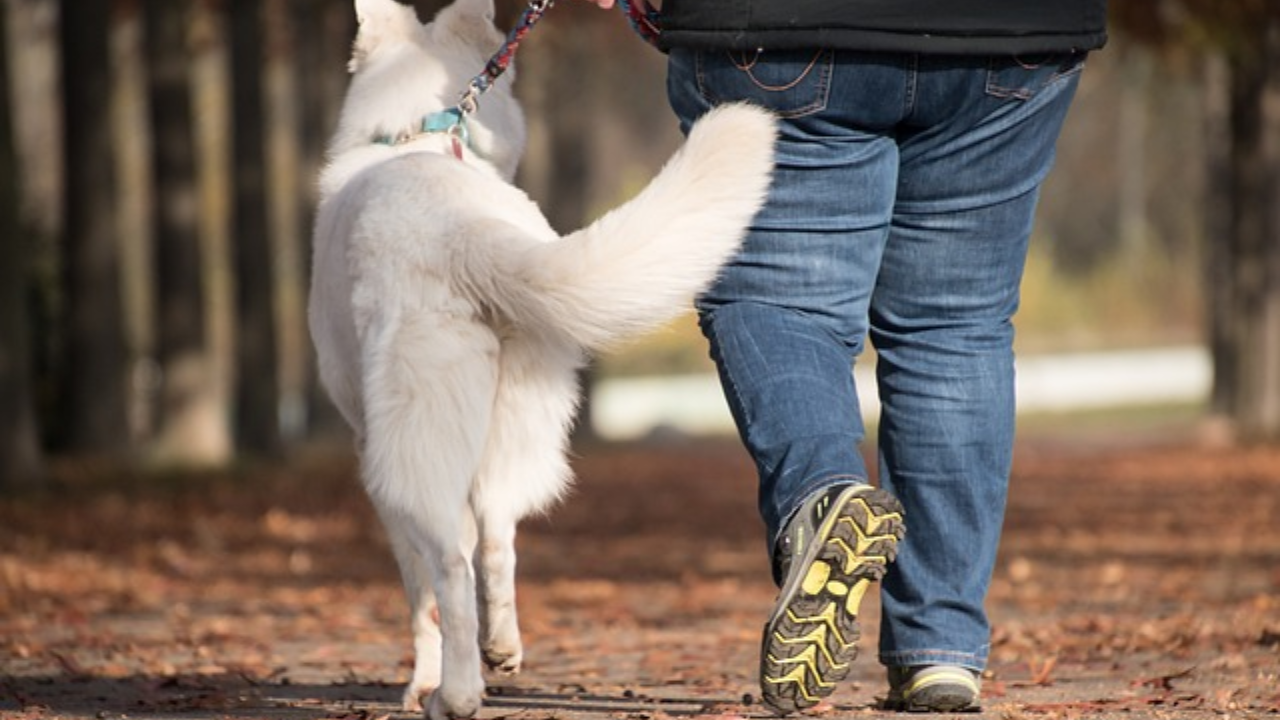
You need to exercise. Your four-legged friend is staring at the leash. What are you waiting for?
Often, in our busy schedules, we can carve out time for regular walks with our dog during the day. In fact, I was astounded that 50% of pet owners do not take their dog walking for regular exercise (1).
This is a wonderful opportunity to recharge and benefit both of you. Your dog can burn off energy, gain some cardiovascular fitness benefits, and maintain a healthy weight, and you can, too! In fact, one study purported that both dogs and their owners would benefit from disease prevention and, thus, significant healthcare cost savings(2).
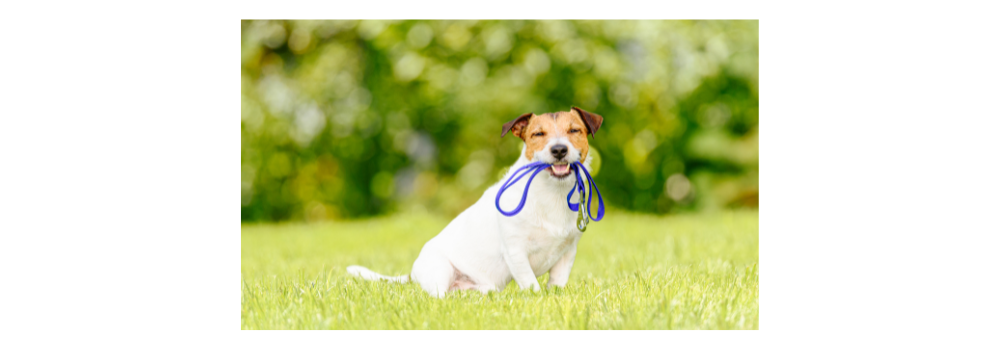
5 reasons why dogs need daily dog walks and regular exercise
- Physical activity is important to maintain a healthy body weight
- Lack of exercise daily leads to muscle atrophy and joint issues associated with immobility
- Exercise helps facilitate bowel function and regular movements
- Frequent walks can allow a senior dog an opportunity to urinate more often and deter urinary tract infections
- Mental stimulation and daily routine enhance your dog's overall health and behavior
All of the above apply to dogs as well as their humans. But did you know that humans benefit by having lower blood pressure and better overall mental health?
How Good Is Walking as Exercise?
Walking your dog has benefits for both you and your dog. Daily dog walks can help stave off boredom and burn calories for active dogs. Walking your dog may also decrease your blood pressure and stress levels. It strengthens the human-animal bond and helps us feel more connected to our neighbors and other dog walkers.
Older dogs may not be able to walk as briskly, but getting out is just as important for their physical and mental health. It may be more of a walk and sniff but this is important for enrichment as they are exploring their environment. If you have a dog that is not as cooperative on walks, try varying the environment and route to entice them to get more exercise.
Walking may also be an excellent time for training. You can ask your dog for a sit at every street crossing, or lie down when a bicycle passes.

How often should you walk younger dogs or puppies?
Many folks ask when they can start running or doing a sustained activity with their puppy. First and foremost, you have to consider where you take your new puppy before it reaches 4 to 5 months of age.
Socialization is a key element in a puppy’s growth and development, you must avoid parks, the beach and green belts where your puppy could be exposed to potentially deadly diseases such as distemper, parvo, and the respiratory infections that continue to circulate. Instead, keep your puppy busy with puppy kindergarten classes for socialization and basic manners.
It's important to avoid running with your puppy early in its life is that canines go through significant developmental changes during the first 14 months of life. Throughout this period, their growth plates are closing and are vulnerable to the concussive effects of sustained running and jumping higher than your wrist height.
Growth plates are located at each end of bones — they are the areas where bones actually lengthen. These areas are the most vulnerable to injury until they calcify when growth is complete. Until then, the plates are soft, and fractures or repetitive micro-trauma to the area can lead to arthritis later in life.
Injury to this vulnerable area can also cause premature closure of the growth plate, ultimately leading to discrepancies in bone length and deformity or deviation from normal conformation (proportionate dimensions).
A rule of thumb for bigger dogs is that the later in the 14-month window, the growth plates will close, and the more susceptible to injury he or she can be. Small dog's growth plates close sooner, and it is not as critical to wait.
It is best to stick with walking, progressing to a brisk walk, as a puppy reaches maturity.
So, What Can I do with My Puppy?
Consider low-impact exercise and lots of play on grass, such as retrieving and working with basic behavior skills such as “stay,” “down,” and “come” when on a long lead.
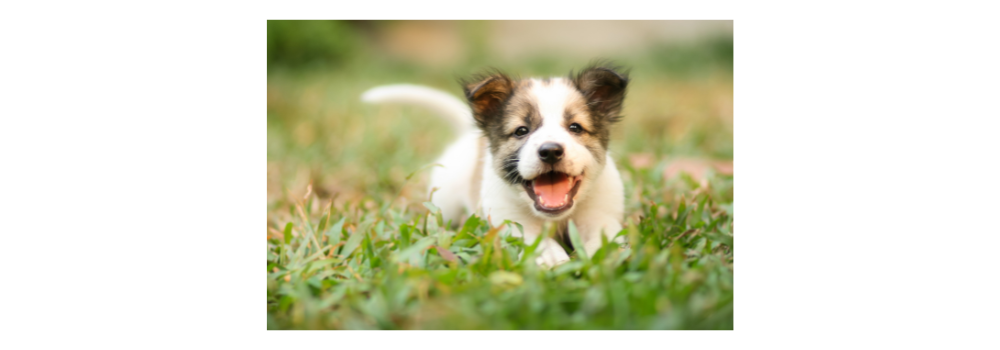
When is it safe to walk a puppy?
Check with your veterinarian, but in general, the last vaccination in the puppy series occurs around 14-16 weeks.
You have to weigh the risk of having a puppy that is not socialized to other animals and people, and protecting your pet from parvovirus and distemper. Ask your veterinarian for a reputable puppy socialization class while you are waiting to go on dog walks.
How often should you walk a puppy?
Once a dog has reached 14 months, you may start with 20 minutes of brisk walking and progressively incorporate some jogging intervals. The dog should be at your side with a slow trot. Swimming my favorite low-impact exercise for young dogs.
If your dog is older than 14 months, start out with progressively longer walks to begin conditioning. Be sure to work on healing your dog so he learns to stay at your side with his front feet, even with yours (I know this can be challenging for some).
Be sure to stop and reward him when he looks up at you while walking at your side. Stop when he gets ahead of you and wait until he comes back. Make him sit before proceeding. He will finally get it when he realizes that pulling and moving ahead stops all the fun.
You can use a head harness such as the Gentle Leader. Dogs tend not to pull as much with this system as it turns their head. There is also a leash called the Buddy System that latches to your waste.
It is best not to feed your dog a meal for up to two hours before running. Small treats are okay. Start with your regular walk and then incorporate periods of jogging. As your dog gets better at staying at your side, you can jog for longer periods.
What About Senior Dogs?
Senior dogs will benefit from shorter walks. Instead, take more frequent walks throughout the day. Try walking a little more when you take your potty breaks. This helps their digestion and elimination, and lessens muscle atrophy. Urinating more frequently is Mother Nature's way of staving off urinary tract infections.
Walk your dog on the lowest impact surface possible.
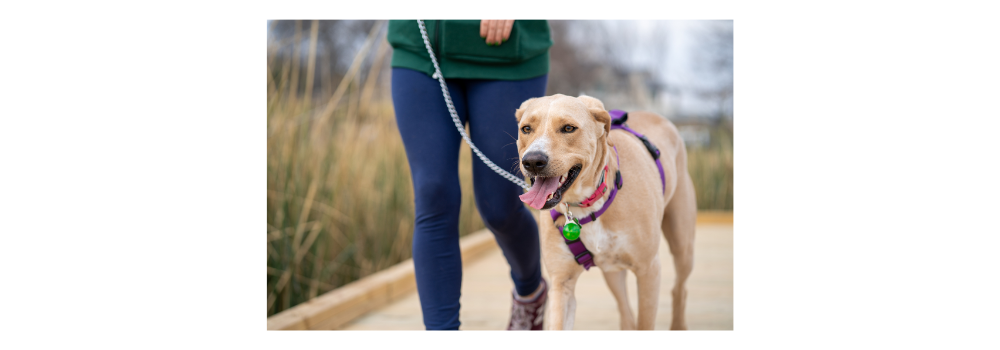
Considerations for overweight dogs, French Bulldogs, and other Dogs that have challenges walking
Dogs that are overweight or have a short nose (bracychephalics) tend to overheat easily and should be walked early morning and evening.
You could consider underwater treadmill therapy for overweight dogs or for when dog walking just isn't in the cards for the pet or the owner. The buoyancy of the water will help make walking much easier for a dog, and the therapist can adjust the speed to accommodate any dog's pace.
As your dog progresses, you can ask your canine rehabilitation therapist to help you with deciding how much exercise would benefit your overweight arthritic dog.
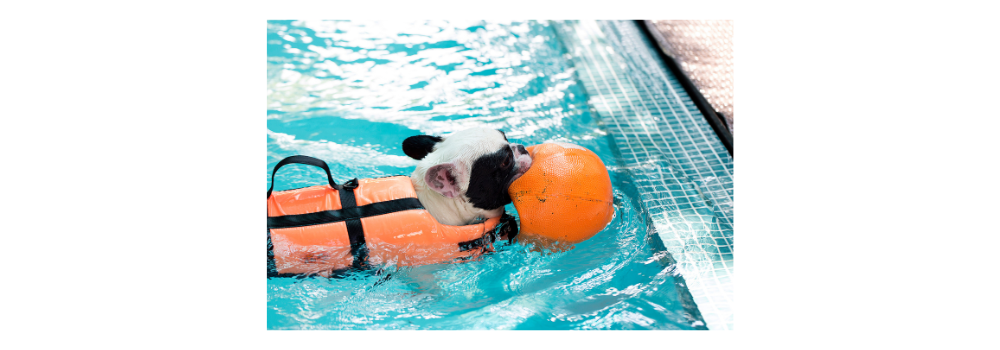
Safety Tips for Handling
I am not a fan of running beside roads with dogs, as they can pull you down if they spot an unexpected rabbit or squirrel. Pavement can be hard on their feet especially if it is hot out.
Consider a reflective collar or lighted tag for walking your dog at night, and wear bright reflective clothing.
Signs your dog may be walking too much
Remember to keep your dog hydrated and watch for signs of overheating. Dogs perspire through panting. When he pants with his tongue just out of his mouth and looks comfortable, keep going. When you notice his tongue hanging out and curling into a spade shape with mouth commissures (the corners of his mouth) pulled back fully, you have exhausted all his cooling options, and you need to give him a break until he starts to breathe more normally.
Lagging behind and obviously trying to stop are signs he is uncomfortable. And especially if he lies down when you are done, you need to scale back your efforts. Many working dogs, such as Labrador retrievers and German shepherds, will do whatever you ask of them, so you have to be their advocate and know when to stop. They will exercise to the point of exhaustion if we let them!
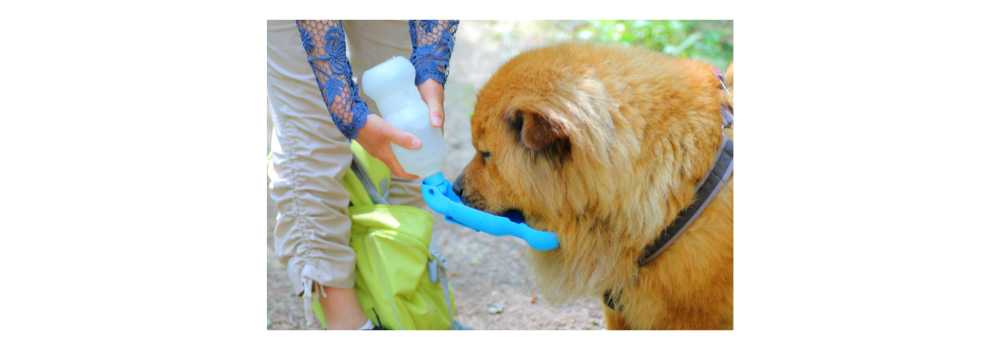
What do I need to walk my dog?
- A traditional leash or for dogs that pull, consider a Gentle Leader, Canine Bridle, or Promise Collar.
- Poop bags
- Water if it is hot out
How often do you walk your dog? Factors to consider
A general rule for regular walks is that you should try to work daily walks twice a day for 15-30 minutes. This does not include the time they are let out in the yard for quick potty breaks.
Consider hiring a dog walker if you cannot walk your dog twice a day. This is especially important for high-energy dog breeds, as physical activity is an important outlet for their energy.
Preventive Medicine and Joint Health
It is important to keep your dog trim to promote healthy joints. You know the old saying, “Food is love.” Well, we love to give our dogs treats. There are aisles of treats dedicated to people who love to feed their pet’s enthusiasm. But it is our job to make sure that our pets do not overindulge.
When I see an overweight 6- or 8-year-old middle-aged large breed dog, I tell the owners they should make an effort to get their pet in shape now rather than pay for costly anti-inflammatory drugs that may tax the pet’s kidneys and liver over time.
Keeping your pet at a healthy weight will also delay the onset of arthritis. If your dog is overweight, consider swimming and underwater treadmill therapy, as this allows the cardiovascular benefits of exercise without the concussive effects of gravity and weight. Walking on grass is also beneficial as it has less impact than pavement.
Be sure to give your pet fish oil, chondroitin, and glucosamine as these are all naturally anti-inflammatory, and they help delay the effect of arthritis and wear and tear on the joints.
Chiropractic care is also important to keep a healthy spine and improve mobility. Overweight dogs or those with hip or knee issues place extra stress on the spine and should be evaluated and treated.
The health of your dog and the #1 Epidemic in Dogs
The surge in obesity rates in dogs is a concerning trend that can be attributed to a few key factors, most notably improper diet and lack of exercise. Just like us humans, dogs need a well-balanced diet and regular physical activity to maintain a healthy weight. However, in our busy lives, we often resort to convenient, processed pet foods that are loaded with fillers and unhealthy additives. These foods may be easy to serve, but they do not provide the necessary nutrients for our furry friends. Moreover, many of us are guilty of over-indulging our pets with treats, further contributing to their weight gain.
When compared to humans, the obesity rate is higher in dogs because they rely on us for their food and exercise. While we have the choice to eat healthily and work out regularly, our dogs don't. They eat what we give them. Therefore, it's crucial to incorporate quality ingredients into their meals, such as those found in Holistic Vet Blend products, and ensure they get enough exercise.
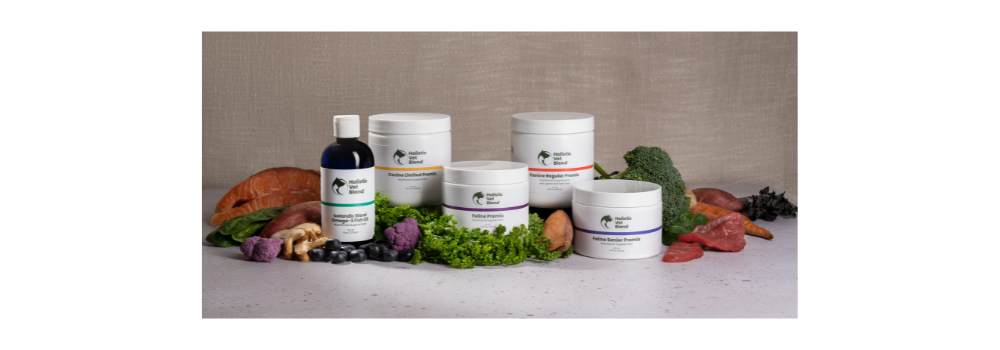
Over the years, I've seen remarkable changes in dogs who switch to homemade meals prepared with premium, nutrient-rich ingredients and have an active lifestyle. Their energy levels increase, their coats become shinier, and most importantly, they reach and maintain a healthy weight. If your dog has health issues and physical exercise is a challenge
Consider a wagon, stroller, or bike trailer if your dog has trouble walking due to arthritis or weakness. You can take them out periodically for bouts of short walks, a bathroom break, and repeat.
Another fun enrichment activity that is low impact is to take your dog walks at the beach. The sand is low impact, and spending time at the beach does a world of good for pet parents, too!
Take advantage of calm waters to walk your dog in shallow water or even do a little swimming.
How do I know if my dog has had enough exercise?
If your dog walks lead to an exhausted dog, obviously, you are doing too much. Dogs with more energy should rebound quickly after a rest.
Dogs with physical health issues may take more time to rebound and show signs of soreness after long walks. This is your cue to cut back on the length of exercise for your dog.
What if you can't walk your dog?
I'm not a big fan of the dog park for many reasons. Although many dogs at the park are sociable and safe to encounter, it can be difficult to keep your dog safe from respiratory infections, injuries, or dog fights. It's just not worth the risk for me and my dog.
Time for a Lifestyle Change?
Weight control is essential to prevent arthritis progression. Several factors, such as lack of exercise, dog breed, and a dog's health, affect its weight.
A balanced, nutritious diet that is not calorically dense will facilitate losing weight. When you consider kibble has 4-5 times the amount of calories compared to a homemade or many raw diets, you can see how a dog might not feel satisfied when they get much less for their daily requirement.
Consider incorporating some fresh homemade food that will benefit your dog's health. That would be the first recommendation that would be given to a human patient who is in need of a lifestyle change. Get off of processed food! You can try adding some to the kibble you are feeding. Anything will be an upgrade over feeding entirely processed food.
Alright, already, I'll get off my soap box. Download a free mini cookbook here to try some of our recipes! That would make my day.

Physical Activity is Good for Your Dog's Health
Dogs are furry exercise machines that give back way more than any piece of fancy exercise equipment or gym membership. It’s all about the bond you build on those long walks and runs in the fresh air. What grows in that peaceful time is one of the most Zen-producing, centering experiences you will ever have. Don’t forget to stop and sniff the roses and a few fire hydrants along the way.
Citations:
(1)Rhodes RE, Lim C. Understanding action control of daily walking behavior among dog owners: a community survey. BMC Public Health. 2016 Nov 16;16(1):1165. doi: 10.1186/s12889-016-3814-2. PMID: 27852251; PMCID: PMC5112741.
(2)Bauman AE, Russell SJ, Furber SE, Dobson AJ. The epidemiology of dog walking: an unmet need for human and canine health. Med J Aust. 2001 Dec 3-17;175(11-12):632-4. doi: 10.5694/j.1326-5377.2001.tb143757.x. PMID: 11837871.










